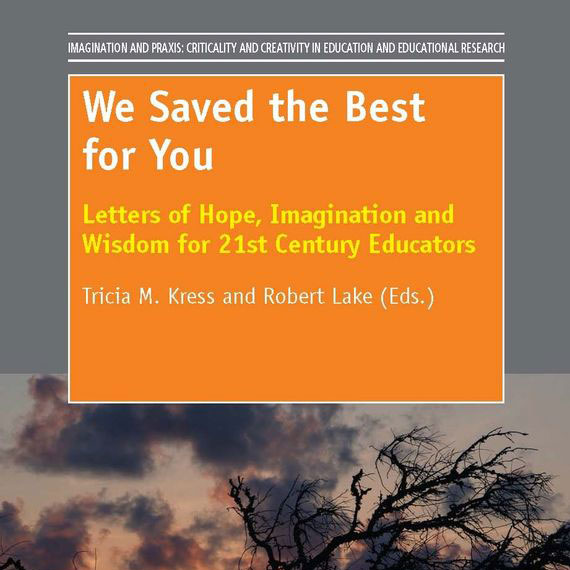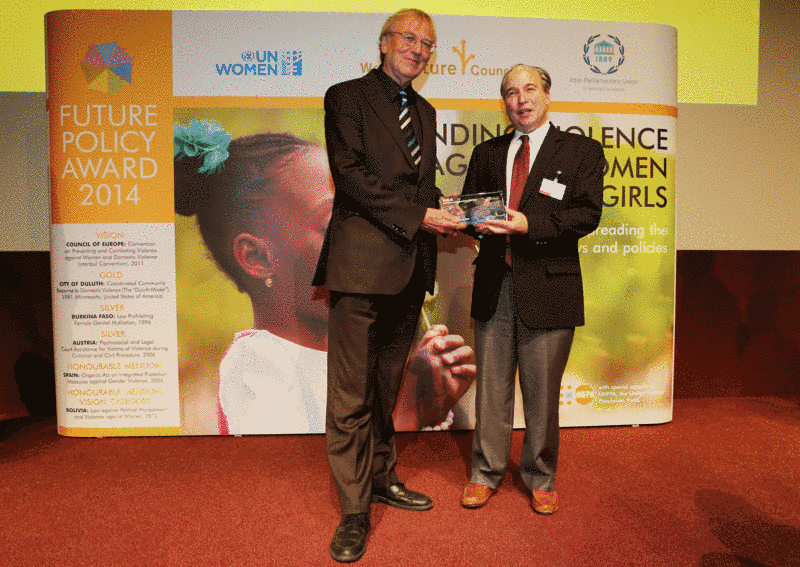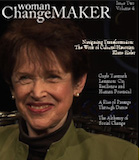From the article: We Saved the Best for You: Letters of Hope, Imagination, and Wisdom for 21st Century Educators, Tricia M. Kress & Robert Lake, eds Boston: Sense Publishers, 2013

Dear Friend and Colleague:
I want to first congratulate you for choosing the profession of teaching, so vital to children’s future – and to us all.
I also teach, not to children but about children, about society, about our collective future. I have done this for decades, through university undergraduate and graduate courses, as well as through my books, articles, speeches, and most recently videos and webinars.
One of my books is about k-12 education, and follows in the tradition of earlier progressive thinkers about education such as Johann Pestalozzi, Maria Montessori, John Dewey, Paolo Freire, and Nel Noddings. 1 The book is Tomorrow’s Children: A Blueprint for Partnership Education in the 21st Century.2 It is designed to help young people better navigate through our difficult times as well as help them create a future orienting more to what in my study of 30,000 years of cultural evolution I have identified as a partnership system rather than domination system of beliefs, institutions, and relations.
Although we may not use the terms domination and partnership, we’re all familiar with these two kinds of relations. We know the pain, fear, and tension of relations based on domination and submission, on coercion and accommodation, of jockeying for control, of trying to manipulate and cajole when we are unable to express our real feelings and needs, of the miserable, awkward tug of war for that illusory moment of power rather than powerlessness, of our unfulfilled yearning for caring and mutuality, of the misery that comes from these relations. Most of us also have, at least intermittently, experienced another way of relating, one where we feel safe and seen for who we truly are, where our essential humanity and that of others shines through, perhaps only for a little while, lifting our hearts and spirits, enfolding us in a sense that the world can after all be right, that we are valued and valuable.
But the partnership and domination systems not only describe individual relationships. They describe systems of belief and social structures that nurture and support — or, alternately, inhibit and undermine — equitable, democratic, nonviolent, and caring relations. These categories also describe two different approaches to socialization, and hence education.
My interest in transformative education is rooted in my early life experiences. On November 10, 1938 – later known as Crystal Night because so much glass was shattered in Jewish stores, homes, and synagogues – a gang of Nazis came for my father, shoved him down the stairs, and dragged him off. Miraculously, my mother obtained his release, and my parents and I fled my native Vienna and eventually got to Cuba. Had we remained in Europe, we would almost certainly have been killed.
These early childhood experiences led to burning questions. Why is there so much cruelty, destructiveness, and hate in the world? Is this our inevitable lot? Or can we create a more peaceful, just, and caring world?
It was only much later that I began to systematically look for answers to these questions. And eventually to answer them I embarked on my own research, which has now been reported in many books and article, including my writings on transformative education.
The Three Components of Partnership Education
As you know, there are three primary elements in education: process (how we learn and teach), structure (the learning environment); and content or curriculum (what we learn and teach).
Partnership process is about how we learn and teach. It applies the guiding template of the partnership system to educational methods and techniques. Are young people treated with caring and respect? Do teachers act as primarily lesson-dispensers and controllers, or more as mentors and facilitators? Are young people learning to work together or must they continuously compete with each other? Are they offered the opportunity for self-directed learning? In short, are students and teachers partners in a meaningful adventure of exploration and learning?
Partnership structure is about where learning and teaching take place: what kind of learning environment we construct. Is the structure of a school, classroom, and/or home school one of top-down authoritarian rankings, or is it a more democratic one? Do students, teachers, and other staff participate in school decision-making and rule-setting? Diagramed on an organizational chart, would decisions flow only from the top down and accountability only from the bottom up, or would there be interactive feedback loops? In short, is the learning environment one of hierarchies of domination ultimately backed up by fear, or is it a combination of horizontal linkings and hierarchies of actualization where power is not used to disempower but to empower?
Partnership content is what we learn and teach. It is the educational curriculum. Does the curriculum effectively teach students not only basic academic and vocational skills but also the life-skills they need to be competent and caring citizens, workers, parents, and community members? Are we telling young people to be responsible, kind, and nonviolent at the same time that the curriculum content still celebrates male violence and conveys environmentally unsustainable and socially irresponsible messages? Does it present science in holistic, relevant ways? Does what is taught as important knowledge and truth include – not just as an add-on, but as integral to what is learned – both the female and male halves of humanity as well as children of various races, ethnicities, and abilities? Does it teach young people the difference between the partnership and domination systems as two basic human possibilities and the feasibility of creating a partnership way of life? Or, both overtly and covertly, is this presented as unrealistic in “the real world”? In short, what kind of view of ourselves, our world, and our roles and responsibilities in it are young people taking away from their schooling?
Much of progressive education has focused primarily on process, and to some degree on structure. This is very important. But partnership education is not only a matter of more self-directed learning, peer teaching, cooperative learning, more individualized assessment tools, and other partnership pedagogies. Nor is it only a matter of a more democratic and participatory structure. It emphasizes the importance of narratives, and specifically what kinds of behaviors and values are presented as valuable in curriculum narratives.
One of the goals of progressive education is to give young people more choices. Yet even in many progressive schools the curriculum offers few alternative narratives. At best it does so in bits and pieces, mostly as add-ons to conventional narratives we inherited from earlier more domination-oriented times. So all too often there is a conflict between the worldviews and values progressive educators talk about and try to model, and the implicit, and even explicit, messages of the narratives or stories that consciously and unconsciously mold what people consider normal and desirable. Hence attention to narratives is a major component of partnership education.
The Power of Stories
We humans live, and all too often die, by stories. No one can ever tell me that the kinds of stories people are told don’t matter. I was almost killed as a child because of stories that Jews are evil and subhuman.
So what stories are children told today?
On all sides, they hear stories that portray us as bad, cruel, violent, and selfish. Video games and action adventure movies and TV shows present violence as the way to solve problems. Situation comedies make insensitivity, rudeness, and cruelty seem funny. Cartoons present violence as exciting, funny, and without real consequences. As in the journalistic motto of “if it bleeds, it leads,” even the stories that make top headlines focus on the infliction and/or suffering of pain as the most significant and newsworthy human events.
And rather than correcting this false image of what it means to be human, much of what children still learn in schools reinforce it. Not only do history curricula still emphasize battles and wars, but classics such as Homer’s Iliad and Shakespeare’s kings trilogy romanticize “heroic violence.” Scientific stories tell children that we are the puppets of “selfish genes” ruthlessly competing on the evolutionary stage.
If we are inherently violent, bad, and selfish, we have to be strictly controlled. This is why stories that claim this is “human nature” are central to an education for a domination system. They are, however, totally inappropriate if young people are to learn to live in democratic, peaceful, equitable, and Earth-honoring ways.
Partnership education offers empirical evidence that our human strivings for love, beauty, and justice are just as rooted in our biology as our capacity for violence and aggression. Young people learn how, by the grace of evolution, biochemicals called neuropeptides reward our species with sensations of pleasure, not only when we are cared for, but also when we care for others.
The study of evolution from this larger perspective does not leave young people with the sense that humans are inherently violent and selfish – in which case, why bother trying to change anything!On the contrary, partnership education is education for positive social action on all levels — from our communities to our community of nations.
A New View of Our Past – and Potential Future
Partnership education offers young people a broader understanding of history that is essential if they are to more effectively participate in creating a more equitable, peaceful, and sustainable future. It shows that the struggle for our future is not between capitalism versus communism, right versus left, or religion versus secularism, but rather between a mounting movement toward partnership relations in all spheres of life and strong dominator systems resistance and periodic regressions.
Using the analytical lens of the partnership/dominator continuum, young people can see that along with the massive technological upheavals of the last three hundred year has come a growing questioning of entrenched patterns of domination. The 18th century rights of man movement challenged the supposedly divinely ordained right of kings to rule, ushering in a shift from authoritarian monarchies to more democratic republics. The 18th and 19th feminist movement challenged men’s supposedly divinely ordained right to rule women and children. The movement against slavery, culminating during both the 19th and 20th centuries in worldwide movements to shift from the colonization and exploitation of indigenous peoples to their independence from foreign rule, as well as movements challenging economic exploitation and injustice, the rise of organized labor, anti-monopoly laws, and economic safety nets such as Social Security and unemployment insurance)also challenged entrenched patterns of domination. The 20th century civil rights and the women’s liberation and women’s rights movements were part of this continuing challenge. So were the 19th century pacifist movement and the 20th century peace movement, the first organized challenge to the violence of war as a means of resolving international conflicts. The more recent movement challenging traditions of violence against women and children in families and other intimate relations is also a challenge to deeply entrenched traditions of domination and violence. The family planning movement has also been critical for women’s emancipation as well as for the alleviation of poverty and greater opportunities for children worldwide. And the environmental movement has frontally challenged the once hallowed “conquest of nature” that many young people today recognize as a threat to their survival.
But history is not a linear forward movement. Precisely because of the strong thrust toward partnership, there has been fierce dominator systems resistance as well as periodic regression. So we also have over the last 300 years seen resurgences of authoritarianism, racism, and religious persecutions – from the Nazis in Germany to the more recent emergence of so-called religious fundamentalism, be it Eastern or Western, Muslim, Christian, or Hindu. In the United States we have seen the repeal of laws providing economic safety nets, renewed opposition to reproductive rights for women, and periodic violence against those seeking greater rights. In Africa and Asia, even after Western colonial regimes were overthrown, we have seen the rise of authoritarian dictatorships by local elites over their own people, resulting in renewed repression, exploitation, and in some places genocidal violence. We have seen a recentralization of economic power under the guise of economic globalization. Under pressure from major economic players, governments have cut social services and shredding economic safety-nets — an “economic restructuring” that is particularly hurtful to women and children worldwide. We have also seen ever more advanced technologies used to exploit, dominate, and kill – as well as to further “man’s conquest of nature,” wreaking ever more environmental damage. We have seen a resurgence of violence against different races, religions, and ethnicities – including terrorist attacks against the United States. And the backlash against women’s rights has been particularly violent, as in the government supported violence against women in fundamentalist regimes such as those in Afghanistan and Iran.
Gender and Education for a Partnership Future
The subordination of women is a key to domination systems, which is one reason a major focus throughout Tomorrow’s Children is a more gender-balanced curriculum.
Many of us are so used to this subordination that we do not even notice that most of what children are taught is still extremely male-centered, from textbook illustrations of primate and human evolution with only male figures to how the canon in just about every field (from art to science) primarily features males. But we must take notice, and change this – not only for the sake of the female half of humanity but for the sake of us all.
This marginalization, and often invisibility, of the female half of humanity perpetuates domination systems. Consider that a male-superior/female-inferior model of our species is a template for learning to associate difference – beginning with the most basic difference between male and female – with superiority or inferiority, dominating or being dominated, being served or serving that can then be applied to different races, religions, ethnicities, and so forth. This is why regressive regimes or would be regimes focus so heavily on “getting women back into their traditional or subservient place.
Of course, we have to change our textbooks to be more gender balanced, and we have to pressure textbook publishers to do so. In the meantime, every teacher can do her of his part by introducing narratives about girls and women in their classes – and Tomorrow’s Children provides many materials for courses ranging from math and reading to literature and social studies.
Moreover, in addition to materials that can be integrated into existing curricula, Tomorrow’s Children provides an exciting new curriculum loom and learning tapestry for those who want a whole-systems approach.
My hope, and goal, is that adapted for different regions and cultures, partnership education can be a blueprint for refocusing, reframing, and redesigning education to help children grow up to be active agents of social transformation. It’s our job – your job – as educators not only to help children meet the challenges of our difficult and increasingly dangerous times but to show them that a partnership future is not a utopia or no place, but a pragmatopia, a possible place – and to provide them with the knowledge and skills to build partnership cultures worldwide.
1. Johann Pestalozzi, Leonard and Gertrude (New York: Gordon Press Publishers, 1976; originally published in 1781); John Dewey, Democracy and Education (New York: The Free Press, 1966; original 1916); Paolo Freire, Pedagogy of the Oppressed (New York: Seabury Press, 1973); Maria Montessori, The Montessori Method (New York: Schocken Books, 1964; original 1912), Nel Noddings, Caring: A Feminine Approach to Ethics & Moral Education (Berkeley: University of California Press, 1984).
2. Riane Eisler, Tomorrow’s Children: A Blueprint for Partnership Education in the 21st Century (Boulder, CO: Westview Press, 2000). For more resources on partnership education and the differences between partnership and domination systems, see e.g., Riane Eisler, The Chalice and The Blade: Our History, Our Future (San Francisco: Harper & Row, 1988; The Power of Partnership: Seven Relationships that Will Change Your Life (Novato, California, 2002); and The Real Wealth of Nations: Creating a Caring Economics (San Francisco: Berrett-Koehler, 2008).


